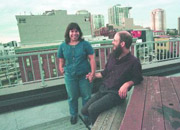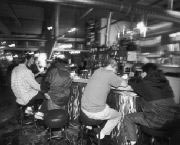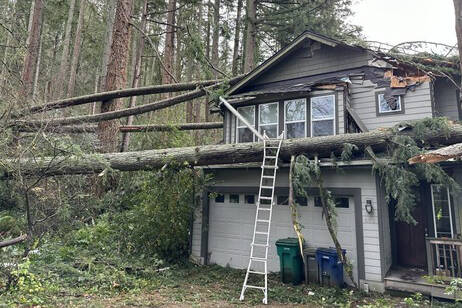NEAR THE CORNER of First and Bell in Belltown, 23 people share two floors of the old Utah Hotel. They’re musicians, writers, civil servants, carpenters, a couple UW students, a Microsoftie, a physical therapist, and a programmer, even a single mom who used to work for a psychic hot line. Each shareholder in the Apex Housing Cooperative has his or her own living space of anywhere from 110 to 350 square feet. The rest of the building is shared as common space. Myke, 39, and Maura Woodwell, 40, (he a mechanical engineer, she a legal assistant) live in a unit on the second floor, sometimes with their 12-year-old daughter, Jessica. Paul Hughes
Seattle Weekly: How is the building laid out?
Myke: The living units all come with a sink, so you’ve got running water to wash up. Each floor also has two kitchens and one big living-room lounge and four bathrooms—and that’s all shared. So you have about five or six people to a kitchen. And you’ve got two big, claw bathtubs, two big, walk-in showers, the lounges, and then access to the roof deck up on top. Between the two floors we’ve got about 11,000 square feet, so as a member, you’ve got access to about 5,000 or 6,000 square feet of space.
What’s the difference between being a renter and being in a co-op?
Myke: I think there’s two aspects to it: One is like if the toilet backs up or something breaks, you’re not going to call the landlord to complain. You’re going to figure out how to fix it yourself. On the other side, we’ve got the original stoves and refrigerators from 1984 . . . and it’s time to replace them. Somebody’s got to go out and look at the catalogs—do you want the cheap ones, do you want the nice ones?
Maura: And that is a big question. [laughs] The process sometimes of all this working together can be a little. . . .
Contentious? Is the mood or atmosphere different because it’s a co-op?
Maura: Yeah, it can be contentious sometimes, but mostly people here work together really well-and know that they have to work together. It’s common sense a lot, but there are a lot of personalities. We don’t try to come to a consensus, most of the time it’s majority rules. Which I think is good.
Myke: We have a consensus a lot of the time. There’s usually a group of folks who want to do something, then there’s a group who wants to do it different, then there’s a third group who couldn’t give a rip, as long as it works, whether you pick blue or yellow.
How much do you do with other people in the co-op?
Myke: You hang out in the lounges, people watch movies together. We’ve been doing common meals four nights out of the week for the last four months. One person cooks one night, and about 12 or 16 people eat.
Do some people make better dinners than others?
Myke: Yes. [laughs] Some people have gotten better over the four months. But in four months, most people only cook four times. And you’ve been fed 16 times a month. That’s worked out really nice.
Do you guys ever feel crowded?
Myke: No, it works pretty good. I think it’s because you’re using your room as kind of work space and sleeping space. But if you want more space, or especially if you want to interact more, you can take a book or the laptop and go sit in the lounge.
Maura: Or up on the roof.
So the public spaces are geared mostly to people being together?
Myke: Yeah, the lounges are set up for having more than one person at a time. You’ll have somebody watching the TV, and somebody doing something else, and then somebody in the kitchen-and that seems to work out pretty good. Although Christine’s kind of taken over the TV one with [1-and-a-half-year-old] Alexis.
Maura: Yeah, Alexis needs a lot of room. [laughs] But if you can jump over all the kids’ toys, you’re OK.
Myke: The kids’ toys and all the chairs lying on their sides making a fence so she can’t get into the kitchen.
Does it feel like a family?
Maura: To a degree, yeah. And I don’t like to equate it with this, but it’s more like a dorm. A lot of people who have the same kind of goals, the same mind-set.
What sort of mind-set?
Myke: We’ve got people who work for Real Change, who work for the [Independent] Media Center, we’ve got people who work for the city of Seattle.
Maura: I’d say “aware.” Everybody in this building is real aware. They know what’s going on around them socially, and a lot of the members are active.
Myke: Yeah, a lot of them are active. Like in the Independent Media Center, doing stuff for WTO. Involved in the bigger neighborhood . . . the bigger political stuff happening around town, like dealing with homeless folks.
Do you feel like you’ve had to make any big sacrifices living in a situation like this?
Myke: There’s not a lot of extra space for stuff. And then you do have to watch that you’re sharing your kitchen with five other people, so you can’t just leave messes or start hanging posters all over the wall.
Maura: They’re not really sacrifices, they’re more like adjustments. If you’re going to have people over for a dinner party, you have to let people know you’ll be occupying the kitchen and the dining room. They’re certainly invited, but . . .
Myke: What’ll end up happening with that is that they’ll join your party and help cook something, and it’ll end up being a bigger event. That’s how the benefits outweigh the drawbacks. You’ve got 20 other people in the building who’ll help you do almost anything. Whether that’s . . .
Maura: A bike courier?
Myke: Right! We’ve got bike couriers in the building, and I do all the stuff for the Belltown P-Patch and I have stuff that has to go to city officials, so I leave it by their door in the morning and it’s down there by 10.
Maura: There’s power in numbers.








